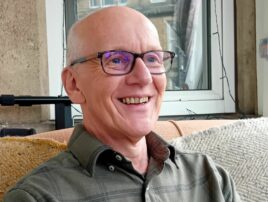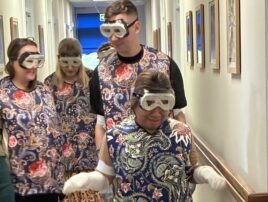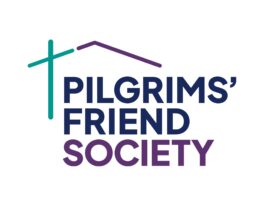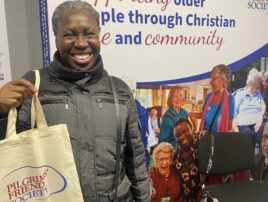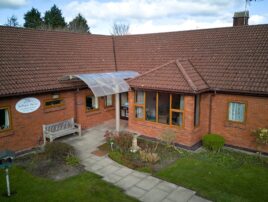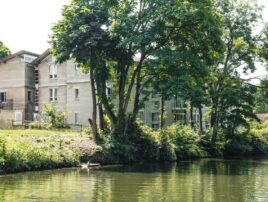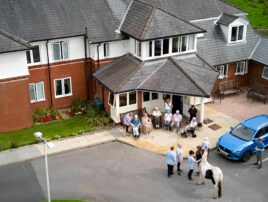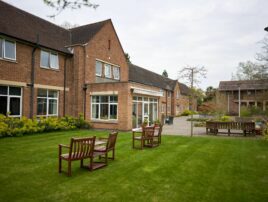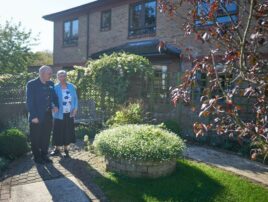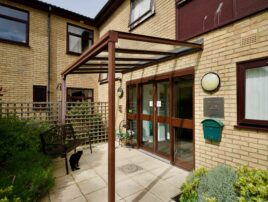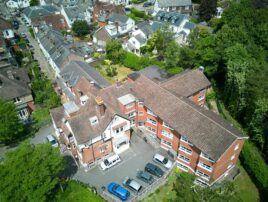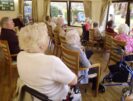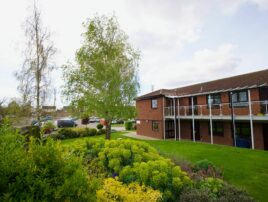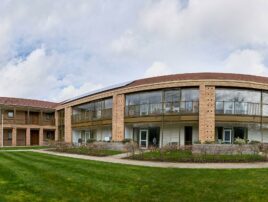
Friday 30th May 2025
Lands of possibility

When Maddie, eight, comes to visit her Great Great Aunty Rachel at Milward House, she always asks to play with the Interplayland. A rounded wooden structure with open sides and dolls house proportions, the Interplayland is brightly coloured and populated by a throng of smiling figures painted to look like older people. Within the Interplayland there are four different ‘lands’ to explore: a care home lounge replete with easy chairs in patterned fabrics, an upright piano and a fluffy white cat; a restaurant with retro wallpaper, bottle lids for plates and lamb hotpot on the menu; a garden with a stylish gazebo and a tree laden with shiny, ripe apples; and a traditional seaside with striped deckchairs, ice cream kiosk and slatted wooden beach hut.
With Maddie absorbed in her play, her mum Katy and Aunty Rachel chat. Everyone is happy and relaxed. “It can be quite daunting for a child to visit a care home,” says Katy. “You come into the lounge and feel like everyone is looking at you. Having something to play with takes the attention away.
For Rachel, who is living with dementia, the Interplayland eases the pressure in a different way. “Maddie might bring something over and the three of us will end up talking about it,” says Katy. “It’s a bit like looking at a book, only tactile. It’s a good diversion, especially at times when Aunty Rachel gets confused.”
A GP for many years, Rachel is a natural carer deeply attuned to the feelings of those around her. Seeing a child playing happily makes her happy too and, over time, the bond between Maddie and Rachel has grown. “When Maddie comes in they’ll have a big hug,” says Katy. “Rachel will ask her questions about her birthday or everyone at home and Maddie will answer quite freely.”


The Interplayland was a gift to Milward House by Ruth Moyler, whose mother Kathleen lived at the home. It has its origins in a model made by Ruth’s daughter while she was studying art and design at the Brit School in 2007. Ruth explains, “For her final piece, she came up with this fabulous model she called ‘the imagination station’ split into different ‘lands’ to showcase the artistic techniques she’d been learning – there was a pirate land with a sea of latex, a jungle with a big cave in it.”
A teacher in early years, Ruth had recently moved to one of the toughest primary schools in Southwark and immediately saw the potential to use the model with her class. “The level of need was high,” says Ruth. “I had children who could barely speak, children who couldn’t sit still. I took the model in and they were absolutely enthralled by all the little details. It’s impossible to have a quick look you have to have a long look.”
A crucial element was the addition of wooden figures, personalised so there was one to represent each child in the class. “They loved having a ‘mini me’,” says Ruth. “They felt real ownership. They’d move their figure around and say, ‘I’m going here’ or ‘I’m doing this’.”
Ruth also used the model to support phonics, a method used to teach reading. “I’d make up little stories, like for the ‘s’ sound I’d have Sarah and Simon sitting on the sofa seeing a spider. The next day, I’d ask the children what we’d been learning about and they’d repeat the story back to me. They came on leaps and bounds.”
The open-sided design meant several children could sit together and play quite happily, fostering good relationships in the classroom.
Such was the success at Ruth’s school that she was asked to create further versions for use in other local schools. Ruth became aware that the name ‘the imagination station’ was already being used as a brand and so she came up with a new name – Interplaylands.


When the pandemic lockdown came, Ruth saw immediately that many children with special educational needs would struggle to access the kind learning being offered online.
This marked a new chapter in the life of her creation – she decided to make personalised Interplaylands for children at the school in Peckham where she now worked that could be used while on a video call with a speech and language therapist. Themes matched the interests of each child – for example one child loved cars and so his Interplayland included a ‘land’ with roads and garages.
She also found that personalised Interplaylands could be used to support children facing trauma and grief. “There was one little boy in our school whose father had left just before lockdown and he was very angry,” says Ruth. “I made an Interplayland for him which included a figure of his father.
He had a wonderful 16-year-old brother who played with it with him every day. They acted out things like going on outings with his father. It seemed to calm him down and gave him a way to explore his feelings.”
Then there was the little girl who had lost her big sister to a rare disease. Ruth made an Interplayland with figures of both girls. The older sister’s figure had gold on her wings and the younger girl could put the figure in the Interplayland’s upper level and say that she was in ‘heaven’.
During the pandemic, Ruth also found that older members of her church were interested in making Interplaylands of their own to help them connect with grandchildren they couldn’t see. The wooden bases were ordered and laser cut by a local business and then people would decorate them with themes to suit their grandchildren’s tastes. “It was a difficult time for everyone and I’m pleased that Interplaylands could in some small way help bridge that gap,” says Ruth. “People couldn’t see their grandchildren but they could put their energy into doing something for them.”

To receive your copy of the magazine FREE four times a year, sign up now.

In December 2022, Ruth’s mother Kathleen came to live at Milward House when she needed 24-hour care. Ruth had been making an Interplayland for a school in Uganda where she has links and when she was finished she decided to bring it in to show everyone.
“I thought the family members would find it interesting, but they were more than just interested,” says Ruth. “Some of them started to move the figures as children would, entering into the world. That got me thinking, what would it be like to make a version of the
Interplayland for a care home?” Ruth spoke to Susan, our Activities and Community Engagement (ACE) Facilitator at Milward House, about what ‘lands’ she thought would resonate with family members and Ruth and her four sisters Rena, Gwyne, Anna and Ju set to work.
In the autumn, Kathleen’s health took a turn for the worse. Ruth and her sisters became frequent visitors to the home, with their brother Tim flying in from overseas. Because Kathleen was sleeping a lot, the family gathered in the home’s smaller lounge and together they worked on the Interplayland for Milward House.
For Ruth, crafting each Interplayland is a labour of love and she delights in coming up with ways to recycle materials and add artistic touches. She traces her own creative journey to the encouragement she and her siblings received from mum Kathleen during childhood.
Both Ruth and her sister Anna grew up to pursue creativity through their work, Ruth in the field of education and play therapy and Anna as a sculptor – the tiny apple tree in the Milward House Interplayland is one of her willow creations. Her other sisters all love to paint and enjoy crafty hobbies while her brother has an aptitude for writing. In turn, Ruth’s daughter also pursued her creative streak and always has a project on the go.
Kathleen passed away in October 2023. Shortly after, the Interplayland was complete and Ruth gifted it to the home. It has since become a highlight for young visitors like Maddie and children from the local Claremont School, opening up possibilities for connection. At other times, it serves as a catalyst for conversation between family members, staff and volunteers, helping everyone get to know each other better.


Ruth herself is a volunteer at the home and enjoys the interactions that arise. “I had one conversation with a lady about the tiny copper pans on the wall in the Interplayland’s kitchen,” she says. “She told me she used to have pans hanging on her kitchen wall when she was younger.”
Prompted by the seaside scene, another family member, David, shared how he used to make and race sailing boats along the south coast of England. Another lady admired the tiny hymn books in the Interplayland’s lounge, leading to the singing of some wellloved choruses.
Ruth sees the Interplayland as a fitting homage to her mum. “I’m excited by the possibilities that the Interplayland has opened up at Milward House, especially how it’s bringing different generations together.
Mum was the one who encouraged me to explore my artistic side. It’s thanks to her that I’m courageously creative, and it’s wonderful that the Interplayland is bringing joy to others, too.”
To find out more about Interplaylands commissions, visit: www.interplaylands.com
Find out more about Milward House...

Meet the ACE Facilitator... Susan Schibli
Susan tells us what drew her to become an Activities and Community Engagement (ACE) Facilitator at Milward House, Tunbridge Wells

Meet a senior night carer...Abraham
Abraham has been a carer at Milward House for 15 years. We explore how caregiving has positively impacted his life

My Story: June
June, 97, enjoyed an incredible career as a professional dancer, sharing the stage with the likes of Margot Fonteyn

